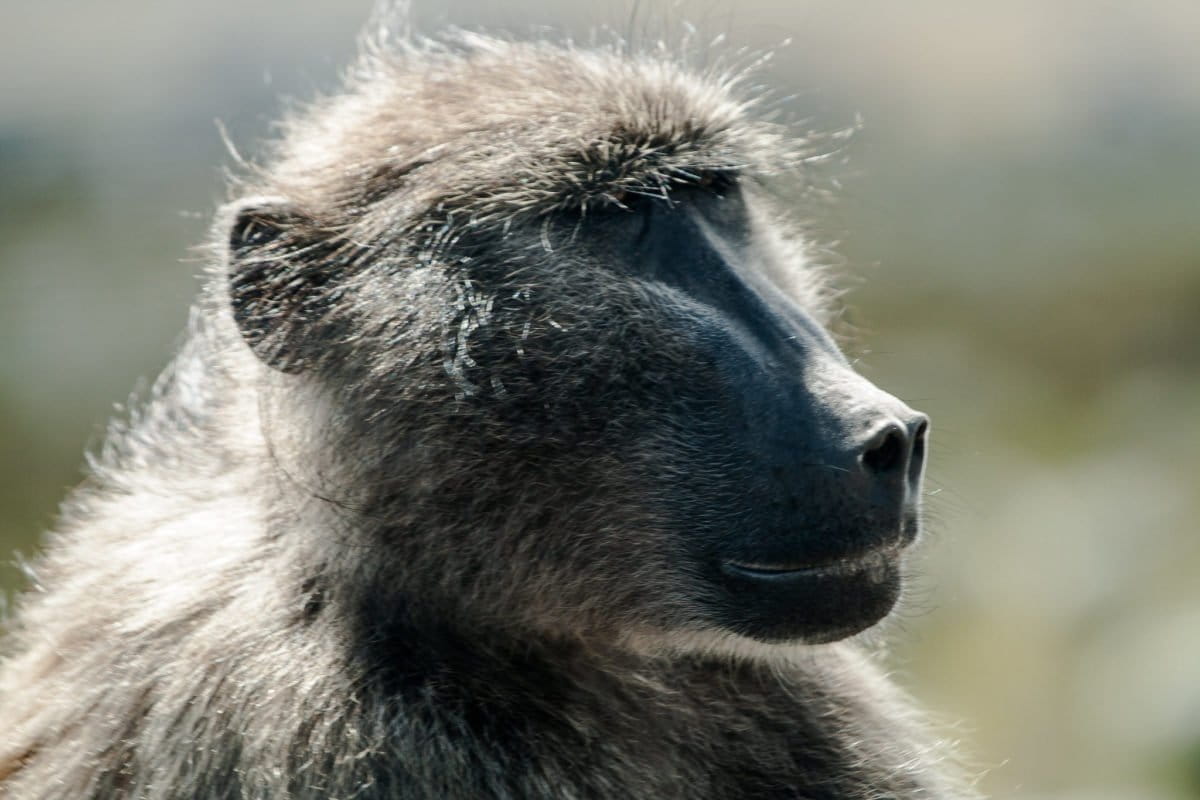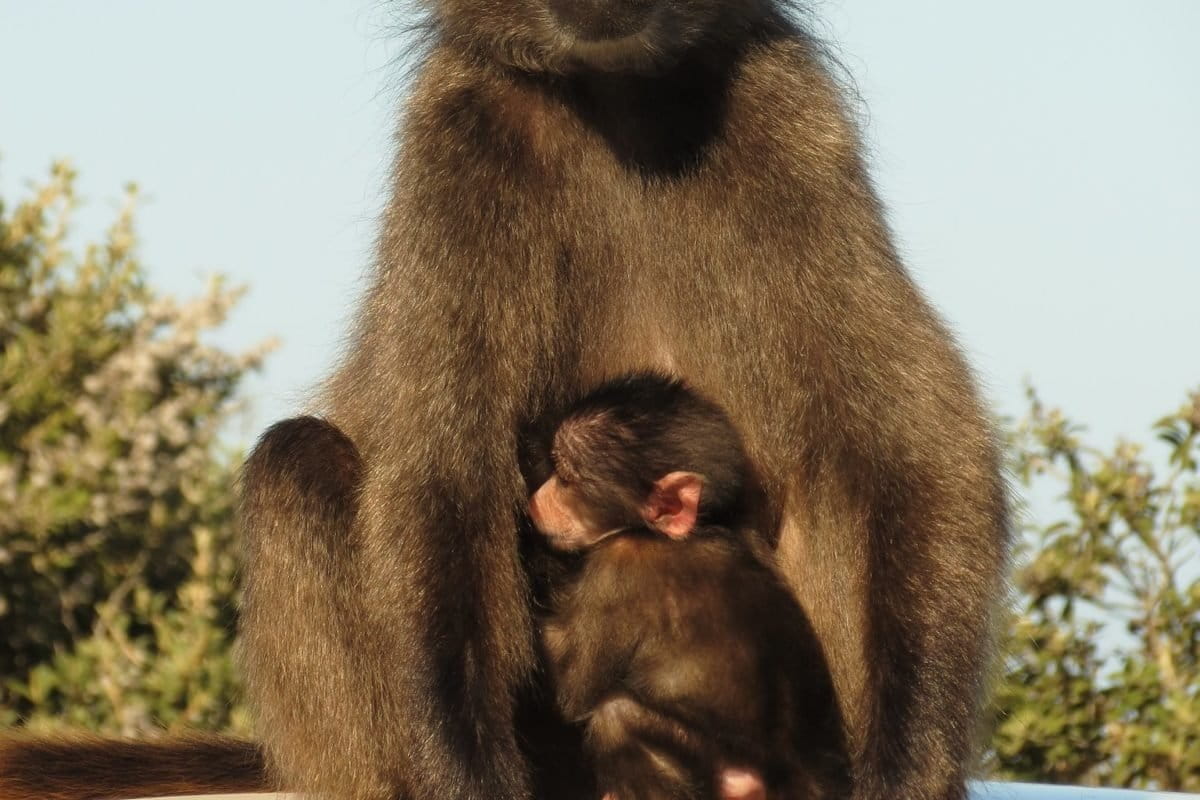- Baboons on South Africa’s Cape Peninsula are attracted to residential areas by the ready availability of food waste and fruit trees.
- The extirpation of the primates’ natural predators and steady growth of human settlements has led to escalating conflict.
- Culling was abandoned as a management method as it was pushing the baboon population toward local extinction.
- Alternative approaches have been complicated by debates over humane methods of deterrence as well as poor enforcement of regulations to make urban areas less attractive to baboons.
CAPE TOWN — In and around Cape Town, expanding urban communities press right up against the protected area of Table Mountain National Park. This gives residents and tourists alike easy access to the mountain, but it also means the Cape Peninsula’s chacma baboons (Papio ursinus) have the same access to residential neighborhoods. Decades of human-wildlife conflict — and human-human conflict over wildlife — have found a precarious balance in the city’s baboon management guidelines.

Breaking the ecosystem
The problem began when settlers “decimated everything,” says Justin O’Riain, a professor and principal investigator at the University of Cape Town’s Institute for Communities and Wildlife in Africa (iCWild).
Lions were hunted out more than a century ago. The last time a leopard was seen on the Cape Peninsula was in the 1930s.
“We broke the ecosystem,” O’Riain says. With fewer predators, the baboon population grew dramatically.
Table Mountain National Park stretches the full length of the peninsula, with the city center at its northern end, and mostly wealthy suburbs running along both sides of a mountainous spine to Cape Point, 50 kilometers (30 miles) to the south. Partway down its length, in Constantia, there are still significant areas of farmland and vineyards on the eastern slopes.
Pine plantations on Table Mountain initially provided the baboons with food and resting places — and mostly kept them away from the growing city below. But as the pines were harvested into the 1960s, the baboons started to move into urban areas in search of food.

Increased conflict between baboons and people led the authorities to cull certain troops in the late 1980s. A 1998 survey of the peninsula’s baboons “painted a bleak picture,” O’Riain says. The population numbered just 365 and there were hardly any males left, as they were the ones most likely to be killed.
Some people, like Jenni Trethowan, were outraged. In 1990, in response to the culling of the troop where she lived, in the southern suburb of Kommetjie, Trethowan co-founded the Kommetjie Environmental Action Group (KEAG) to try and change the city’s baboon management plan.
KEAG called for an end to culling and the introduction of teams of people to monitor and deter baboons. The authorities agreed. Hunting was made an offense.

In 2001, Trethowan left KEAG to found the Baboon Matters Trust, which was granted a contract to manage troops on the Cape Peninsula, primarily using human monitors.
“The other tools were effective bylaws, effective waste management, what plants you planted,” Trethowan tells Mongabay. But with little funding or other resources available for these measures, the focus fell on simply “chasing baboons away from urban areas.”
Data collection and management methods
Heated debate over the effectiveness of baboon management continued, with plenty of strong feelings for and against baboons in the southern peninsula, but very little in the way of actual data tracking where the baboons went, when and why. In 2006, at the request of one of his Ph.D. students, O’Riain established the Baboon Research Unit to provide data for the city. Tracking baboons with GPS collars, the unit confirmed they were still going into residential areas when human monitors were not present.
The baboons had quickly grown accustomed to the monitors’ clapping and shouting. Paintball guns and North American bear bangers were proposed by residents and the Baboon Research Unit, but a report to the local animal welfare organization, the SPCA, put a stop to their use.
Solitary males — which had left their troops to find new ones, often ending up in built-up areas — were becoming dangerous: an elderly man was pushed to his death by a baboon that jumped off him while fleeing a dormitory with a bag of sugar, and a child’s stomach was ripped open in a separate incident.
In 2011, the Baboon Research Unit hosted a workshop attended by city officials, representatives of South African National Parks (SANParks, which manages Table Mountain), and international experts. In her keynote speech, Shirley Strum, a biological anthropologist who has studied crop-raiding baboons in rural Kenya since the 1970s, explained that baboons raid despite the risks because the rewards of calorie-rich human food are so great; X-rays of one Cape Peninsula male baboon revealed 70 pieces of metal in his body — buckshot, rifle bullets and pellets — yet he’d continued to raid.
Strum was horrified to witness baboons mugging people on the peninsula. “The baboons should have been aversively deterred from approaching and feeding on human food from the start,” Strum wrote in an open letter published in the Cape Times several months later.
She wrote that she was shocked by the animal welfare activists campaigning against many of the proposed measures. “I care about baboons as much or more than they do. But because I care, I would sacrifice some to save the whole if that is what it takes. By contrast, activists seem to only care about how ‘the humans’ feel about baboons.”

New guidelines
Following the workshop, the city awarded a 9 million rand per year ($628,000) baboon management contract to a new company, Human Wildlife Solutions (HWS).
New guidelines included monitors to drive baboons away from urban areas — the SPCA approved the use paintball guns and bear bangers — and a renewed effort to involve residents in making their homes less attractive to raiders.
Under a baboon raiding protocol devised by the city, SANParks and the provincial conservation body CapeNature in 2009, when a “problem” baboon is identified, he — and they are nearly all male — is tagged and fitted with a radio collar to track his movements. A charge sheet details his background and the date and types of interaction.
On the charge sheet for one raiding male, there are 140 recorded incidents over 13 months, including raiding bins, and entering cars and an occupied house. He formed a splinter group with other baboons, who followed him into urban areas (HWS now actively prevents such splinter groups from forming). In response, HWS held community meetings, delivered pamphlets about bin locks and other proofing measures, and erected signage on the roads. Area managers conducted door-to-door outreach about managing waste and identifying access points: broken burglar bars or an open back door. A fruit tree was removed.
If a baboon continues to enter homes and cars after a full range of deterrents has been tried, the box is ticked to suggest it should be euthanized. A panel reviews the charge sheet and a decision is made.
Between 2009 and 2018, 75 baboons were euthanized under the protocol, 44 of which were aggressive habitual raiders. Protocol mortalities have fallen from 5% of the population in 2012, when most of the habitual raiders were identified and put down, to 1% in 2018.
HWS currently employs 60 rangers to monitor 11 managed troops (449 baboons as of June 2019). The rangers are with them from sunrise until sunset. Swansea University Ph.D. student Gaelle Fehlmann’s research shows that the managed troops now stay out of settled areas more than 95% of the time.
“What’s so cool,” says Esme Beamish, a University of Cape Town Ph.D. candidate who has been studying the baboons since 2005, “is that the program is underpinned by research and data. The authorities are informed.”
Beamish’s research shows the baboon population is growing again, largely because of a drop in non-protocol, human-induced deaths: between 2006 and 2019, baboons in the peninsula’s northern troops (living near vineyards and other agriculture in the middle section of the peninsula) increased by 97% overall, while troops living close to urban areas further south grew by 22%.
A bone of contention is that the HWS contract — the value of which has risen to 12 million rand per year ($837,000) — does not extend to agricultural areas such as the Constantia wine farms, though these farmers still pay rates that fund the HWS contract. In 2018, feeling they had few other options, farmers obtained permits from CapeNature and shot seven baboons. Whether the farms will be absorbed into HWS’s mandate is currently being discussed.

Going forward
Through its successes and misjudgements, there are many lessons Cape Town can offer other cities. The importance of protecting predators in the first instance; protocols for identifying specific animals rather than generic culling; respecting scientific data; and overall collaboration are all key lessons and suggestions for a rapidly urbanizing world.
For O’Riain, the goal was always “a healthy, viable, sustainable population with improved welfare and improved conservation.” The current data look good, but there remains work to be done — not least to plan for the future as both baboon and human populations increase.
To curb the growth of the baboon population, the city’s Baboon Technical Team will begin implementing birth control through contraception for females and males and will continue to keep baboons away from anthropogenic food sources — a contributing factor to population growth. Culling is currently off the agenda.
Beamish thinks young male baboons are still being failed, as there’s not enough manpower for each lone male to be monitored. She says they need to develop ways to prevents males entering towns as they move between troops — something increasingly difficult in the face of urban sprawl.
A baboon-proof electric fence in the Zwaanswyk area has proven successful. O’Riain says he would like to see one in the suburb of Scarborough, too, where there’s a lot of baboon raiding.
Scarborough, on the southwestern coast of the peninsula, illustrates the widely differing attitudes of residents — some allegedly welcoming the baboons into their homes, while others are desperate to get rid of them by any means necessary. Capturing and sending Scarborough’s last four female baboons to a sanctuary is a last-ditch, one-off solution, suggests O’Riain, to prevent the growth of the troop and more conflict, while avoiding the PR fallout of euthanizing them.
Poor waste management remains a problem across the southern peninsula. The Simon’s Town naval base, for instance, is a hotspot for baboon raiding because food waste is easily accessible. The City of Cape Town requires residents in baboon raiding areas to have lockable bins secured with two padlocks. These are supposed to be provided for free in baboon-affected areas, but are not readily available and are considered ill-designed and ineffective, says Beamish.
Proposed amendments to existing bylaws will specify how waste should be managed in baboon-affected areas and help enforce proper practices, though it remains to be seen whether the amendments will be adopted.
In the village of Rooi-Els, on the east side of False Bay, Overstrand Municipality bylaws do state that residents must secure their waste in baboon-proof bins. Responsible waste disposal, alongside baboon-proof windows and doors, have helped keep the peace — baboons continue to come into town, but they tend to spend their time foraging in the vegetation around properties, rather than raiding.
Banner image: Baboons in Tokai, Cape Town. Image by Ted Matherly via Flickr (CC BY-NC-2.0)
FEEDBACK: Use this form to send a message to the author of this post. If you want to post a public comment, you can do that at the bottom of the page.
